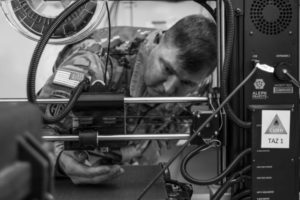The Army has approved a new advanced manufacturing policy to bolster the use of 3D printing and robotics to build materials for new capabilities, and push for future contracts to include requirements encouraging contractors to use additive manufacturing practices.
In a memo detailing the new policy, Secretary Ryan McCarthy said 3D printing would allow the Army to avoid design limitations imposed by traditional manufacturing methods and improve readiness by allowing the service to more rapidly produce lighter, stronger parts.

“Advanced manufacturing will fundamentally change the way the Army designs, delivers, produces, and sustains materiel capabilities. It will enable the Army to modernize systems while simultaneously enhancing readiness,” McCarthy wrote.
Under the new policy, Bruce Jette, the Army’s top acquisition official, will serve as the lead for advanced manufacturing, including developing an implementation plan.
Jette is also tasked with revising Army procurement-related regulations within the next two years to reflect an emphasis on using advanced manufacturing and 3D printing.
Army’s modernization-focused Futures Command will take on putting together a strategy on encouraging industry’s use of advanced manufacturing and improving the Army’s ability to seamlessly fold in these new practices into development of future weapons systems.
Army Materiel Command (AMC) will stand up an advanced manufacturing center of excellence to account for adjustments to logistics capabilities and develop a plan to bolster industry’s advanced manufacturing capacity for components.
“Advanced manufacturing enhances the supply chain and sustainment efforts, both forward in the field and in our maintenance depots, enabling soldiers to quickly manufacture critical parts and supplies at the point of need,” Gen. Gus Perna, commanding general of AMC, said in a statement.
Implementing the new policy will include accounting for performance and readiness capabilities that can be gained by incorporating advanced manufacturing into new programs, and in turn writing in requirements for future contract that would benefit from utilzing 3D printing and robotics to build parts.
The Army noted the policy extends to sustainment work, and will encourage the use of advanced manufacturing for producing spare components to ensure fewer programs face challenges with obsolescent parts.